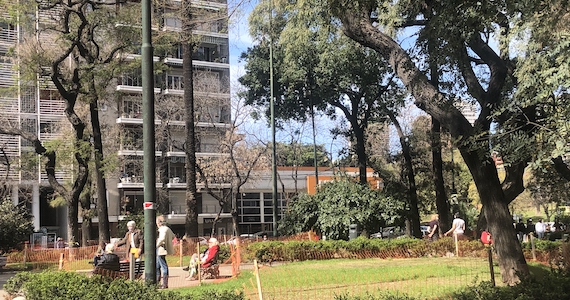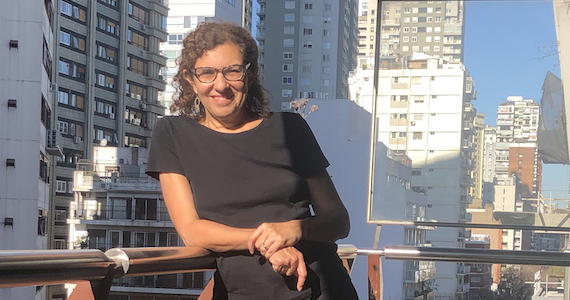Letter from Buenos Aires
Posted on
August 31, 2021
 The Palermo neighborhood in Buenos Aires where Dean Diez Roux is visiting her parents.
The Palermo neighborhood in Buenos Aires where Dean Diez Roux is visiting her parents.
By Ana V. Diez Roux, MD, PhD, MPH
This month I write to you from Buenos Aires, the city where I was born, and the place I still consider my home, although I have now spent most of my life outside of it. I have come to see my parents, 86 and 87 years old. They still live here just a few blocks from each other in a neighborhood called Palermo, not the new Palermo (the fancy hipster neighborhoods of Palermo Hollywood and Palermo Soho) but the other older Palermo with high rises intermingled with remnants of old houses, many sadly converted into commercial spaces although you can still glimpse the beautiful architecture above the gaudy advertisements.
What is referred to as the City of Buenos Aires is home to about 3 million people, but this is only the core of a sprawling metropolitan area of nearly 17 million people (over a third of the entire population of Argentina) extended over 13,000 square kilometers. Like many cities in Latin America (and also all over the world) Buenos Aires is characterized by enormous inequalities reflected in its neighborhoods and visible every day as you walk down the street. Men push large carts loaded with cardboard and bottles zigzagging in between expensive cars as they search for garbage they can sell; young boys visit the outdoor tables as posh restaurants selling little packets of Kleenex for whatever you are willing to give; women with sleeping babies in arms ask you for change as you enter a store. As a pediatrician, the faces of these children are familiar to me. Years ago I measured them and weighed them and auscultated their lungs, prescribed largely unnecessary medication and mostly listened to their parents’ stories of troubles and perseverance. It was these experiences that got me into public health.
Like many cities Buenos Aires shows dramatic differences in health as well as social and environmental conditions across its neighborhoods. It is estimated that today over 40 percent of its population lives in poverty. As in other cities the rich and the poor live in different worlds. Although public hospitals struggle to provide care to everyone, the health care system remains fragmented and disorganized, emphasizing tertiary over primary care. Traffic and its health and environmental consequences (including noise and air pollution) remains a major problem. There are glimmers of hope though: in some parts of the city rapid buses now travel through a central corridor greatly facilitating bus transport (the metrobus), a bike lane passes by my mother’s apartment, and orange stations of a bike share program free to residents during weekdays have popped up in some parts of the city. All this of course is a far cry from addressing the transportation needs of the millions who continue to commute every day for hours on crowded buses and trains.
And then of course there is COVID. After being one of the countries with the highest COVID death rates despite a strict lockdown early in the pandemic, cases in Argentina have begun to decline (the delta variant is not yet fully here) and vaccination is gradually increasing although it remains low (still only under a third of the population has two doses). My parents received the Sputnik and Astra Zeneca vaccines, and growing proportions of the populations have received mixtures (Sputnik and Moderna or other combinations). Of course wealthy Argentinians (like many other wealthy Latin Americans) travelled to Miami earlier in the pandemic to get Pfizer. Ongoing discussions about the pandemic are similar to those occurring all over the world: should indoor dining be open, should children go to school, are workers being properly protected? Health is front and center of the political debate as it never has been. There is actually discussion of reforming Argentina’s fragmented health insurance system (although skepticism abounds as to whether this will ever be done) and a former minister of health is a candidate for city “diputado” (a member of the house of representatives) promising to usher in a new way of governing that prioritizes “health and education.”
Despite all the challenges, the city is vibrant. In my neighborhood the plazas are full of children, restaurant tables spill out onto the sidewalks, flower stalls sell fragrant fresias and jazmines, coffee shops full of Argentinians in leisurely conversation dot almost every corner, and bakeries and verdulerias (fruit and vegetable stalls) are on every block. I can see a life here that can be fulfilling and rich and yes, healthy. But there is so much to do structurally, systemically to bring this life to everyone in cities like Buenos Aires, in Latin America, and all over the world, so much that the pandemic has now highlighted more than ever: housing, transportation, work conditions, health care and the stark inequities everywhere…
Spring is beginning here in the southern hemisphere. My mother has not ventured out since the pandemic began except to go to the doctor. In her first outing she leans heavily on my arm as we walk slowly to a coffee shop a block away to sip cortaditos outside. I push my father in his wheelchair (navigating the wheelchair is unfriendly on Buenos Aires streets!) to a parrilla we always go to, now also with tables on the sidewalk, for lunch. I see in them the effects of the pandemic, the long months of isolation and worry, the forced withdrawal from life that this pandemic has meant for them as it has for so many. But it is spring, and we go out, the sun is warm, the children play in the plazas, and we can smell the fresias as we walk by the flower stalls.
